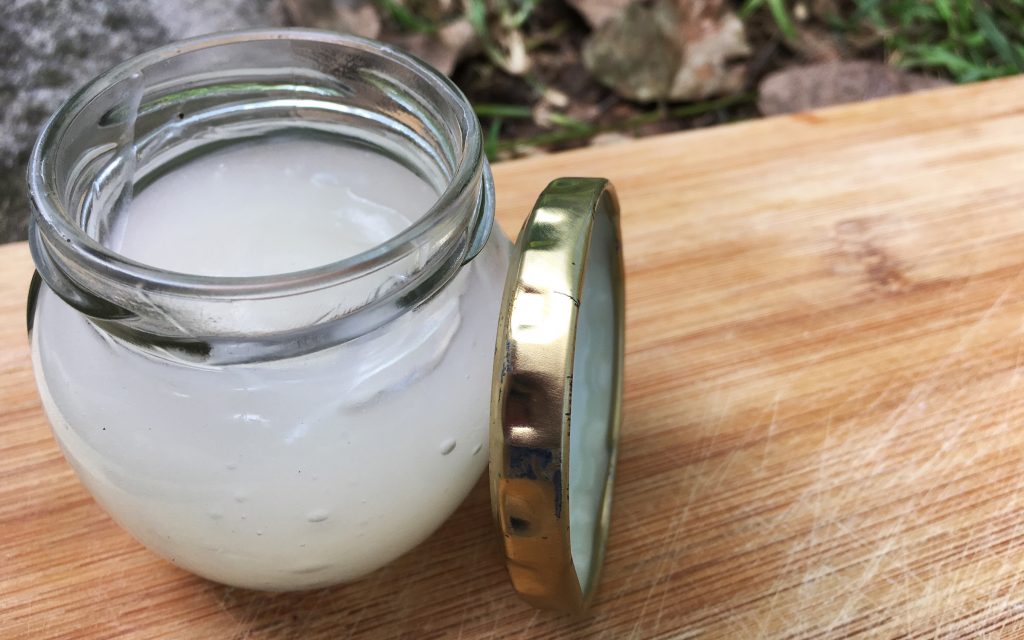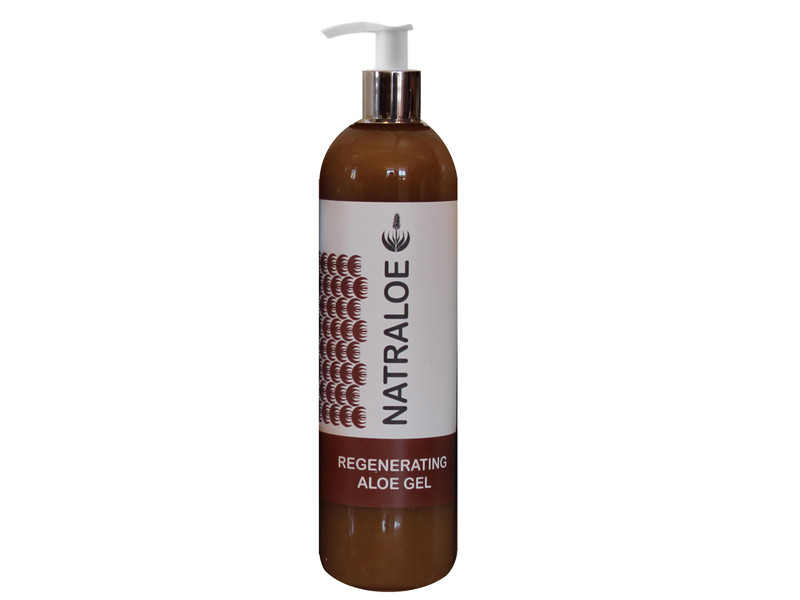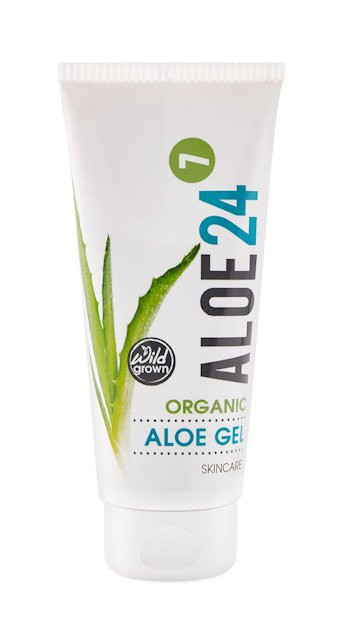Some beginner DIYers have told me that they avoid making their own moisturisers, because most DIY recipes are oil-based and they do not like the oily residue. This recipe is for those people. I created this nourishing, yet non-greasy suspension which you can whip up in less than five minutes.
This moisturiser uses aloe vera gel as its base. The trick to creating a non-greasy moisturiser – a true lotion – is to mix oil and water. Oil nourishes, and water is easily absorbed and non-greasy. Mix the two together, and you have a perfectly nourishing lotion that doesn’t leave you looking like a glazed donut. However, in order to mix oil and water you need something called an emulsifier. This recipe, however, is the simplest non-greasy moisturiser, because it doesn’t require an emulsifier. It is a suspension, not an emulsion. If you want to go down that slightly-more-complicated road, then here is my basic emulsion recipe, which will have the same texture as store-bought lotions.

Non-Greasy Moisturiser
Ingredients
- 100ml Aloe Gel (Store-bought product that is already preserved)
- 1 Teaspoon (5ml) Vitamin E Oil (or 2 large capsules)
- 50 drops (2.5ml) Jojoba Oil (Substitute: Sweet Almond or Grapeseed oil)
- 10 drops (0.5ml) Carrot Seed essential oil (optional)
Instructions
- Combine jojoba oil, carrot seed oil and vitamin E oil together. Mix well.
- Add this oil mixture to the aloe vera gel, and mix thoroughly until combined. Stir until you no longer notice any visible layer of oil. The oil droplets should be suspended evenly throughout the aloe gel.
- Transfer mixture into a sterilised container.
- Store in a cool place, out of direct sunlight and use within 6 months.
Notes
You can use any essential oil(s) of your choice in this recipe. I use carrot seed for its anti-ageing properties.
Recipe variations
The most basic recipe only requires aloe vera gel and vitamin e oil – all other ingredients are optional. You can use any aloe gel (like aloe ferox, for example) it doesn’t have to be aloe vera. You could also use freshly harvested aloe gel from your garden, however, the shelf life will be significantly shorter and you will have to use the product immediately. To extend the shelf life of fresh aloe, you will have to add a preservative. Although I think jojoba oil works best, you can substitute this with any other carrier oil. You can also use whichever essential oils you prefer – I chose carrot seed for its anti-ageing properties.
COST & SHELF LIFE
Cost Price: R107.90 per 100ml.
Lasted me about: 2 months using a pea-sized amount on my face every morning and evening.
Estimated shelf life: 6 months if stored away from direct sunlight and moisture.
*Costs accurate at the time of writing, and based on the best retail prices I’ve found.
CHALLENGE
Aloe vera gel is expensive: Even without the optional ingredients, aloe vera gel is more expensive to use as a base, when you compare it to the cost of oil-based recipes.
CHERRY ON TOP
No oily or greasy residue: This moisturiser absorbs perfectly while still providing your skin with the nourishment it needs.
INGREDIENTS
- Aloe vera / Aloe ferox gel: moisturizes dry skin without giving it a greasy feel. It contains antioxidants including, beta carotene, vitamin C and E that can help improve the skin’s natural firmness and keep the skin hydrated. It also provides relief for very dry, itchy, flaky or sunburned skin. (Buy here or see my shopping guide for other trusted brands)
- Vitamin E oil: An antioxidant that protects the skin from further sun damage and helps to decrease the signs of lines and wrinkles. (Buy from Faithful to Nature or Dischem)
- Jojoba oil: Has a similar structure to that of sebum, which allows it to absorb easily and readily into your skin. It is not technically an oil, but a wax that mimics collagen, which makes it a gentle and less greasy moisturizer for all skin types. (Buy from Faithful to Nature or Dischem)
- Carrot seed EO: rich in Carotene and Vitamin-A, both of which are very beneficial for the skin and are effective antioxidants. Repairs a lot of the damages done to your tissues by free radicals and prevents them from doing further harm. (Buy here)
Need help finding these, or other ingredients? My shopping guide may help you.
RECOMMENDED RETAIL OPTIONS
If you don’t want to make it yourself, then these are some natural aloe gel-based products which I have personally used and approved:

1.) Natraloe Regenerating Aloe Gel: This is the most cost-effective aloe gel I’ve found, and it also contains the best ingredients. You get the most bang for your buck here at about R185 for 250ml. When I cannot find 100% aloe vera gel, I use this in my recipe instead.

2.) Totally Wild Organic Aloe Gel: This is the more costly option at about R100 for 100ml, but it is a certified organic product after all. That said, it’s a great price for a certified organic product. It contains magnificent ingredients and has a lovely texture, although the fragrance may not be for everyone.
Do you think that this is a good non-greasy moisturiser recipe? If you’ve tried it, please share your feedback in the comments below.

HI there, I’ve only just been introduced to the awesome, captivating world of essential oils and I’m learning something new everyday. I came across your blog site quite by chance and I’m hooked 🙂 Very simple recipes with loads of accompanying information!
I just had a quick query with regards EOs: Is it necessary to use “organic” EOs in skin/hair formulations? Or can I just use EOs that are not branded “organic” but are from a trustworthy source? Organic oils are so much more expensive, and since I’m only just starting out on my EO journey I’m not sure yet of how much I’d like to invest in it. On the other hand, I would be willing (albeit hesitantly) to pay for the best ingredients since I will ultimately be using these formulations on myself and my kids.
Please do point me in the right direction.
Cheers
JP
Hi JP
Thank you for your comment. I am happy to hear that you discovered my blog by chance, and that you are hooked! That is very encouraging.
To answer your question – No, I personally do not think that it is necessary to use organic EOs. I don’t. I buy organic EOs when I can afford it, but otherwise I am happy to use non-organic if it comes from a reputable source. The most important criteria, in my opinion, is ensuring that the essential oils you buy are therapeutic grade (not food grade, or perfume grade). Many essential oil labels will say “pure” or “100%”, but don’t trust that. Always check that the ingredient is listed by its biological name, and perhaps ask the company what grade their essential oils are. So don’t buy oils that list “lavender oil” as the ingredient. Rather buy the product that lists “Lavandula angustifolia”. Organic simply means that the herbs were grown without inorganic pesticides, fertilisers and that the seeds were organic/ heirloom (as opposed to GMO) etc. So this does have minor long-term health benefits, but it does not affect the potency or effectiveness of the essential oil itself. An organic oil is the purest and most natural form, but non-organic versions do the job just as effectively. Using essential oils, organic or not, is already a thousand times healthier than using chemically-laden products. Also, buying organic has ethical implications – you are supporting farmers who use eco-friendly and sustainable methods. But that is a personal choice, albeit an expensive one. So, the bottom line, is that if you and your kids eat ordinary fruits & veggies from the store (not organic produce), then it’s just the same as using non-organic essential oils. An apple is still good for you, and won’t harm you – but, obviously an organic apple is the best. If you eat many apples every single day, then you may want to consider eating organic, but if you eat apples every so often then non-organic apples are fine. The same goes for essential oils. The essential oils that I use everyday are organic – but the others are not. I use lavender, peppermint, chamomile and rosemary every day. So those are organic. But the rest of my collection is non-organic.
I hope that helps to answer your question.
Kind regards
Christina
Thanks Christina, that was extremely helpful!! I loved the analogy to fruits, makes the whole concept so much easier to understand 🙂 I reckon I will use the same criteria: ideally use organic when using an oil extensively.
I just made your car freshener recipe; works a treat. Next on my list is your body mist recipe and roll-on deo. Can’t wait to try them 🙂
Would you be posting recipes on how to make basic makeup, such as eyeliner, lipstick, foundation, perhaps? I am a minimal make up person, but would love to go the essential oil way, if possible, in the realm of makeup as well.
Cheers
JP
Hi JP
I’m glad the analogy was helpful 🙂 Thank you for your feedback on the car freshener. It’s always great to hear when someone else makes my recipe and enjoys it as much as I do. I look forward to your feedback on the other recipes you attempt, starting with the body mist and roll-on.
To answer your question, yes, it is on my to-do-list to post recipes on makeup. I have my recipes for all that you mentioned, but I just need to test the product before posting it. So it may be a little while, because I have a long list of other recipes to publish that have been tested. At the moment, I am buying natural makeup from Inthusiasm. They’re affordable and their products are amazing! Perhaps you can try them out in the meantime.
All the best with your future DIY recipes.
Best regards,
Christina
Thankyou for the recipe 🙂
What is the best way to measure 100ml
Well, the density of aloe gel is 1.1 which is close to that of water. So the most accurate way would be to weigh it on a scale – measure 91 grams of aloe. But the easiest way would be to just measure the volume in a measuring jug. You don’t have to be super strict with the measurements with this recipe, it’s pretty flexible. You could go quite a bit over or under the amount of aloe, and it won’t flop.
Hi Connie,
This recipe is not too strict on the measurement, so it’s okay if you are slightly over or under. I usually measure 100ml with a measuring cup, or I use weight and measure 100g with my scale. I hope that helps you.
Regards,
Christina
I use this almost every day (it’s actually finished now I need to make more) and I love it soooooo much! Just a beautiful face mist that refreshes and cares for my skin!
Hi, just wanted to mention, you can also add some arrowroot powder/flour to lessen the greasy/oily look of creams 😉
By the way, I made your lip balm yesterday (tinted with a bit of beet powder infused in sweet almond oil and strained with a rooibos tea bag – haha). Made for my 3 kiddies and myself, LOVE it!! Thank you for the easy recipe!
Hi Adele,
Thank you for your tip. I’ll definitely try that out – would never have thought to use arrowroot powder / flour. I’m so glad to hear about your lip balm – brilliant idea to infuse with rooibos. I hope you find many more go-to recipes on this blog.
Regards,
Christina
You’re welcome!! And thank you 🙂 kids love their lip balms as well!!
I’m looking for a diy sun protection oil (like KiddieKix Little Explorer).. do you maybe have any ideas? Or should I email you with my thoughts and possible ingredients then maybe we can work on this together? (I’ll do the “lie in the sun and see”-test on myself.. haha)!!
Kind regards
Adele
I’m happy the lip balm works for you and your kids too 🙂
As for sun protection oil, I really don’t recommend that you make this yourself Adele. It’s dangerous. There is so much that goes into making a sunblock that actually protects you from free radical damage and skin cancer. This is the one thing I always buy, for safety reasons. I’ve written an article about it – you can read the details about why I don’t make sunblock here. Please be careful, and consider buying a certified natural brand instead.
Sincerely,
Christina
Can this be used as an all over body lotion also!
Yes, of course. It may get a bit pricey when you have to make enough for your body, but if you can find aloe gel at a good price, or if you harvest your own aloe, then that would be perfect 🙂
Hey, can you explain to me why the aloe vera gel and oil mixture doesn’t need an emulsifier?
Hello Vey. Thank you for your question. This recipe is not an emulsion, which is why I’ve called it a “moisturiser”. The vitamin E oil and jojoba oil dilute the essential oils, and these oils together are able to be suspended in the dense viscosity of aloe gel. I originally formulated this beginner recipe as a lighter alternative for people who don’t have access to emulsifying wax, because the only other option is rich oil-based products. Store-bought aloe gel is already preserved, so the shelf life is based on this and the oils used. Of course, you can add an emulsifier to this recipe in order to make a true lotion. Though, you would have to convert the ingredients to percentages, so that you can measure by weight instead of volume. I hope that clarifies.